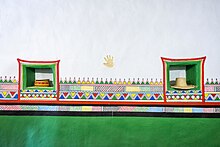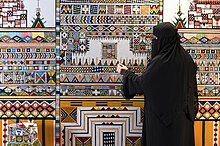This is the current revision of this page, as edited by Ferclopedio (talk | contribs) at 19:06, 6 December 2024. The present address (URL) is a permanent link to this version.
Revision as of 19:06, 6 December 2024 by Ferclopedio (talk | contribs)(diff) ← Previous revision | Latest revision (diff) | Newer revision → (diff) Traditional art style from Saudi Arabia and Yemen
| Al-Qatt Al-Asiri, female traditional interior wall decoration in Asir, Saudi Arabia | |
|---|---|
| UNESCO Intangible Cultural Heritage | |
| Country | Saudi Arabia |
| Reference | 01261 |
| Region | Arab States |
| Inscription history | |
| Inscription | 2017 (12th session) |
| List | Representative |
Al-Qatt Al-Asiri (also called nagash painting or majlis painting), is a style of Arabic art, typically painted by women in the entrance to a home. It originated in the 'Asir Region of Saudi Arabia where the front parlour of traditional Arab homes typically contained wall paintings in the form of a mural or fresco with geometric designs in bright colors. Called nagash in Arabic, the wall paintings are often considered a mark of pride. In 2017 Al-Qatt Al-Asiri was inscribed on UNESCO's list of Intangible Cultural Heritage of Humanity.
Women’s artwork

Women in the Asir region are traditionally responsible for plastering and painting the walls, corridors, and ceilings of their homes. A family’s wealth is often signified by the skill, color, and complexity of the paintings, with poorer homes decorated in basic straight, simple lines in red, green, yellow, and brown. Women within the same neighborhood sometimes compete to make the most vivid and extravagant designs.
Women's artwork is heavily influenced by their love for music, their view of culture and general perception of life; for example, the artwork of more conservative women is more likely to feature conservative and modest colors.
The interior walls of the home are brightly painted, employing defined patterns of lines, triangles, squares, diagonals and tree-like patterns. The geometric designs and heavy lines seem to be adapted from the area’s textile and weaving patterns.
Women from the region sometimes sell miniature 'Asiri houses as souvenirs and bric-à-brac, which are popular among Saudi city-dwellers, who find these colorful houses a source of wonder.
Airport art
The Saudi provincial airport in Abha reflects the region's cultural heritage. Airport Director Abdul Aziz Abu Harba said that "the seating arrangement at the airport lounge has been in the form of a traditional majlis and the walls are painted in various colors reflecting the natural beauty of Asir".
References
- ^ Yunis, Alia, "The Majlis Painters," Archived 2013-08-30 at the Wayback Machine Saudi Aramco World Magazine, July/August 2013, pages 24-31.
- "Al-Qatt Al-Asiri". UNESCO. Retrieved 19 September 2018.
- "UNESCO - 'Al-Qatt al-Asiri', decoración mural tradicional de las mujeres de Asir". ich.unesco.org (in Spanish). Retrieved 2022-05-10.
- "Saudi Aramco World : Doors of the Kingdom". archive.aramcoworld.com. Retrieved 2022-05-10.
- Maha Al Faisal and Khalid Azzam. 1999 Archived 2014-01-02 at the Wayback Machine. "Doors of the Kingdom" Saudi Aaramco World. This article appeared on pages 68-77 of the January/February 1999 print edition of Saudi Aramco World]
- Ni'Mah Isma'il Nawwab (1998). "The Suqs of 'Asir". Archived from the original on 2012-05-07. Retrieved 2013-07-19.
{{cite magazine}}: Cite magazine requires|magazine=(help) This article appeared on pages 2-9 of the July/August 1998 print edition of Saudi Aramco World. - Mishaal Al-Tamimi (19 May 2011). "2011 "Abha airport reflects heritage". Arab News. Retrieved 19 September 2018.
